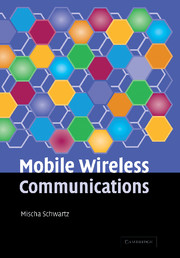Book contents
- Frontmatter
- Contents
- Preface
- 1 Introduction and overview
- 2 Characteristics of the mobile radio environment–propagation phenomena
- 3 Cellular concept and channel allocation
- 4 Dynamic channel allocation and power control
- 5 Modulation techniques
- 6 Multiple access techniques: FDMA, TDMA, CDMA; system capacity comparisons
- 7 Coding for error detection and correction
- 8 Second-generation, digital, wireless systems
- 9 Performance analysis: admission control and handoffs
- 10 2.5G/3G Mobile wireless systems: packet-switched data
- 11 Access and scheduling techniques in cellular systems
- 12 Wireless LANs and personal-area networks
- References
- Index
2 - Characteristics of the mobile radio environment–propagation phenomena
Published online by Cambridge University Press: 05 June 2012
- Frontmatter
- Contents
- Preface
- 1 Introduction and overview
- 2 Characteristics of the mobile radio environment–propagation phenomena
- 3 Cellular concept and channel allocation
- 4 Dynamic channel allocation and power control
- 5 Modulation techniques
- 6 Multiple access techniques: FDMA, TDMA, CDMA; system capacity comparisons
- 7 Coding for error detection and correction
- 8 Second-generation, digital, wireless systems
- 9 Performance analysis: admission control and handoffs
- 10 2.5G/3G Mobile wireless systems: packet-switched data
- 11 Access and scheduling techniques in cellular systems
- 12 Wireless LANs and personal-area networks
- References
- Index
Summary
In Chapter 1, in which we provided an overview of the topics to be discussed in this book, we noted that radio propagation conditions play a critical role in the operation of mobile wireless systems. They determine the performance of these systems, whether used to transmit real-time voice messages, data, or other types of communication traffic. It thus behooves us to describe the impact of the wireless medium in some detail, before moving on to other aspects of the wireless communication process. This we do in this chapter. Recall also, from Chapter 1, that the radio or wireless path normally described in wireless systems corresponds to the radio link between a mobile user station and the base station with which it communicates. It is the base station that is, in turn, connected to the wired network over which communication signals will travel. Modern wireless systems are usually divided into geographically distinct areas called cells, each controlled by a base station. We shall have more to say about cells and cellular structures in later chapters. (An exception is made in Chapter 12, the last chapter of this book, in which we discuss small-sized wireless networks for which the concepts of base stations and cells generally play no role.) The focus here is on one cell and the propagation conditions encountered by signals traversing the wireless link between base station and mobile terminal.
- Type
- Chapter
- Information
- Mobile Wireless Communications , pp. 16 - 61Publisher: Cambridge University PressPrint publication year: 2004
- 4
- Cited by



